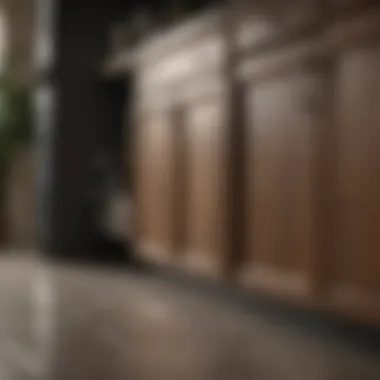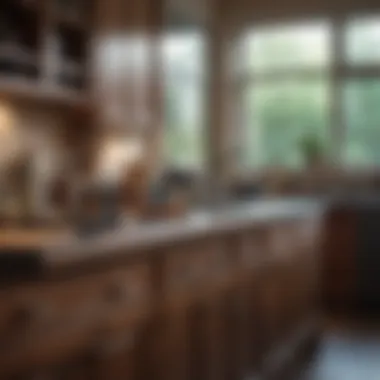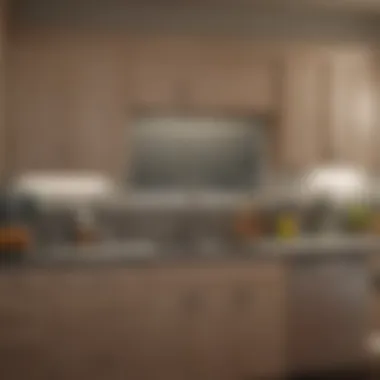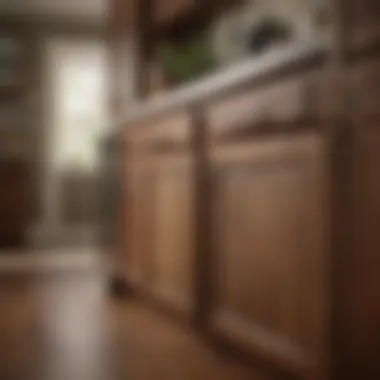Can I Reface My Kitchen Cabinets Myself?


Intro
Refacing kitchen cabinets has gained popularity as a cost-effective means of revitalizing home interiors. Many homeowners now consider this project, either out of a desire to update their home aesthetics or as a response to changing lifestyle needs. However, the question remains: can it be done independently?
This article delves into the feasibility of tackling such a task without hiring professionals. It provides essential insights into preparations, necessary materials, and techniques that can enhance the outcome. This exploration also touches on potential challenges that individuals may face, alongside cost considerations that come into play. By understanding the skills and tools required, readers can better evaluate their capacity for this project or determine when to seek external help. Ultimately, the goal is to equip you with knowledge, enabling informed decision-making about your kitchen cabinet refacing journey.
Design Trends
When considering refacing kitchen cabinets, it's vital to stay up-to-date with current design trends. These trends influence not just aesthetics but also functionality and overall home value.
Current Popular Styles
Many homeowners lean towards specific styles to achieve a modern look. Some of the most popular styles include:
- Minimalist: Characterized by clean lines and uncluttered surfaces, this style emphasizes simplicity.
- Shaker: Known for its versatile and timeless appeal, the Shaker style blends well with various home decor.
- Contemporary: Featuring bold designs and varied materials, contemporary cabinets often utilize innovative techniques.
These styles reflect an emphasis on efficiency and open spaces, encouraging a straightforward yet refined aesthetic.
Color Palettes for Modern Spaces
Color choice plays a significant role in the overall success of cabinet refacing. Popular color palettes that resonate with modern design include:
- Neutrals: Shades like white, gray, and beige create a calming and spacious feel.
- Bold Accent Colors: Deep blues, burnt oranges, or forest greens can serve as focal points, making the kitchen lively without overwhelming it.
- Wood Finishes: Natural wood tones bring warmth and can complement various color schemes, enhancing the tactile experience of the kitchen space.
The careful selection of colors can significantly influence the atmosphere of the kitchen, encouraging choices that resonate with personal style.
"Choosing the right style and color is not just about aesthetics; it’s about creating an environment that feels like home."
Finale
With this understanding of design trends, homeowners can make more informed choices in their kitchen cabinet refacing projects. The right combination of style and color not only meets aesthetic goals but also enhances functionality and improves the overall value of the home. As we move into the next sections, we will explore practical steps and considerations to make this endeavor a success.
Prologue to Kitchen Cabinet Refacing
Refacing kitchen cabinets is a compelling option for homeowners looking to rejuvenate their kitchen's aesthetic without the extensive costs associated with a full remodel. This approach allows for a significant transformation by merely altering the cabinet fronts, which can dramatically improve the kitchen’s overall appeal. In this guide, we will delve deep into the practicalities of kitchen cabinet refacing, offering insights that will aid in self-assessment and preparation.
Defining Cabinet Refacing
Cabinet refacing involves replacing the exterior parts of existing cabinets while retaining the original framework. This process typically includes installing new doors, drawer fronts, and veneer to the cabinet boxes. Refacing provides a fresh look with less material waste. It can effectively emulate the appearance of new cabinets at a fraction of the cost, making it an appealing choice for budget-conscious individuals.
Several materials are commonly used in this process. Thermofoil, solid wood, and laminate are popular choices for cabinet doors. Additionally, applying a new veneer to the cabinet boxes can enhance the aesthetic while ensuring durability. The fundamental concept is to revitalize without the need for structural changes, keeping the kitchen functional.
Reasons for Refacing Cabinets
The motivations behind cabinet refacing are varied, yet they generally revolve around aesthetics, functionality, and cost-effectiveness. Here's a deeper look:
- Cost Savings: One of the primary reasons homeowners opt for refacing is the significant savings compared to a full cabinet replacement. Labor costs are generally lower, and the overall investment is often more manageable.
- Minimal Disruption: Unlike a complete kitchen remodel, refacing cabinets allows for a quicker turnaround. The process typically takes less time and creates less mess, minimizing the disruption to daily life.
- Customization Options: Homeowners gain the freedom to select styles and finishes that resonate with their personal aesthetics. This customization is appealing for those who wish to keep their individual tastes prominent in their home décor.
- Sustainability: Refacing cabinets aligns with eco-friendly trends. It reduces waste by repurposing existing structures, which not only lessens environmental impact but also resonates with the growing desire for sustainable home improvements.
- Enhanced Home Value: An updated kitchen can indeed increase the market value of a home. Fresh-looking kitchen spaces attract buyers, making a well-executed refacing project a worthwhile investment.
Understanding these elements lays the groundwork for considering whether you can embark on a DIY cabinet refacing project. It helps you to gauge the importance of skills and tools required as you prepare to make aesthetic advancements in your kitchen.
Self-Assessment: Are You Ready to Reface?
Before embarking on the journey of refacing your kitchen cabinets, it is essential to assess your readiness for the task. Refacing cabinets is not merely a paint job or surface-level transformation. It requires a combination of skills, time commitment, and space preparation. Understanding your capabilities in these areas will ensure a smoother process and may prevent costly errors.
Evaluating Your Skills


Taking a moment to evaluate your skills can be crucial. This task typically involves several manual skills such as measuring, cutting, and adhering materials. If you have experience in DIY projects or woodworking, you may find cabinet refacing manageable. A good grasp of basic tools, like a utility knife, screwdriver, and safety equipment, is important.
However, if you feel unsure about using these tools or lack basic crafting experience, you may want to reconsider. Understanding your comfort level with tasks like sanding, applying adhesive, and finishing touches is critical.
Assessing your skills honestly can save you from potential frustration down the line.
Time Commitment
Refacing kitchen cabinets is not a quick task. It involves multiple steps, from the initial removal of old hardware to applying the new veneer, and then reinstalling everything. Depending on the size of your kitchen and the complexity of your design, this can take several days or even weeks. Time management is crucial, especially if you plan to use your kitchen during the process.
Creating a timeline can help keep your project on track. Allocate time for each phase: preparation, application, and finishing. If you cannot dedicate sufficient time consistently, you might want to think about the feasibility of this endeavor.
Space Preparation
Preparing your workspace is the next logical step. Ensure you have a clean and organized area to work. This helps not only with efficiency but also safety. Gather all necessary materials and tools in one location to minimize movement around your house, which could introduce disruption or accidents.
Consider aspects like ventilation if you plan on using strong adhesives. A well-ventilated space will prevent inhalation of harmful fumes. Additionally, covering nearby surfaces or having protective sheets around can preserve your home from potential damage during the process.
Understanding the Materials Needed
When undertaking the task of kitchen cabinet refacing, an understanding of materials is critical. The right materials not only affect the finished look but also influence the durability and effectiveness of your efforts. It is important to consider factors like ease of use, longevity, and cost-efficiency when selecting materials. Choosing appropriate materials can help ensure a smoother process and a satisfactory end result.
Types of Veneer
Veneer is a thin layer of wood that can be applied to cabinetry for a refreshed appearance. There are several types of veneer available, each with distinct characteristics:
- Natural Wood Veneer: This type showcases the authentic grain and character of wood. It often requires sealing and staining to protect the surface, but the beauty it adds is unparalleled.
- Reconstituted Veneer: Made from reprocessed wood, this type can mimic the appearance of exotic woods without the cost. It provides uniformity in color but may lack some natural variations.
- Laminates: While not technically a veneer, laminates offer an affordable alternative. They are made from synthetic materials and come in various designs and colors. Their durability beats that of natural options, but they might not provide the classic look many desire.
Selecting the right type of veneer should align with the desired aesthetic and budget. Each option presents unique benefits and drawbacks, and a careful evaluation based on your specific needs will contribute to a useful decision.
Adhesives and Tools
Equipping yourself with the right adhesives and tools is equally important for a successful cabinet refacing project. Traditional methods may not be suitable for modern materials, so understanding what works best is vital.
- Adhesives: Using the appropriate adhesive can make or break your project. Common options include:
- Tools: The tools you choose will significantly affect the ease and quality of your work. Key tools include:
- Contact Cement: Ideal for laminates and veneer due to its strong bond. However, it can be messier to work with.
- PVA Glue: Good for smaller applications. It's water-based and easy to clean up.
- Hot Glue: Quick to set but not ideal for heavy-use areas due to its lower durability.
- Utility Knife: Essential for precise cuts.
- Scraper: Useful for smoothing edges and ensuring adherence.
- Sandpaper: Enables surface preparation, ensuring better adhesion.
- Clamps: Help secure the veneer while the adhesive sets.
It is recommended to gather tools and adhesives before beginning your re-facing project. Having these materials on hand streamlines the process and helps avoid potential setbacks.
"Choosing the right materials directly impacts the quality and longevity of your cabinet refacing project. Make informed decisions for best results."
Step-by-Step Guide to Cabinet Refacing
Refacing kitchen cabinets is a meticulous but rewarding task. It's essential to understand the steps involved in this process to achieve a quality finish. The right approach can vastly improve the appearance of your kitchen without the expense of a complete remodel. A methodical guide helps in eliminating errors, ensuring that each phase of the refacing project is executed effectively. This structured manner of addressing the project allows for careful planning and resource management.
Removal of Old Doors and Hardware
To start refacing, the first step involves removing the existing cabinet doors and their hardware. This step is crucial as it permits access to the surfaces needing work. Begin by unscrewing the handles, hinges, and any other fixtures from the cabinet doors.
- Inspect each door: Take note of how each component is attached, so reinstalling them later is easier.
- Group items: Place screws and hardware in labeled containers to prevent loss.
- Remove the doors: Carefully, taking care not to damage the cabinets themselves.
Once all doors are detached, make a thorough examination of the cabinetry. Look for any damage or imperfections on the surfaces. This scrutiny can identify potential problems, like warped or cracked wood, that may need addressing before proceeding.


Surface Preparation Techniques
Preparation is a key part of the refacing process. The surfaces must be appropriately cleaned and treated to achieve the best adhesion of the new veneer.
- Cleaning: Start with a detergent solution to remove grease and grime. A clean surface is essential for effective veneer application.
- Sanding: Lightly sand the surfaces of the cabinets with fine-grit sandpaper. This helps enhance the stickiness of the adhesive and veneer. Make sure to remove any dust left from sanding.
- Priming (if needed): Depending on the type of materials being used, consider applying a primer to ensure optimal adhesion, especially on slick surfaces.
These steps ensure that the surfaces are primed for the new veneer, leading to a more durable and professional-looking finish.
Applying the Veneer
Next is the application of the veneer. This step is where the transformative effect of refacing becomes visible. It requires precision to ensure that the veneer fits well and adheres properly. Here is how to go about it:
- Measuring and Cutting: Measure the cabinet surfaces accurately, allowing for slight overlaps. Use a utility knife to cut the veneer precisely.
- Applying Adhesive: Use a quality wood adhesive as per the product instructions. Spread it evenly across the cabinet surface using a roller or brush.
- Placing the Veneer: Carefully place the veneer onto the cabinet surfaces, maintaining alignment. Press it down firmly to avoid air pockets.
- Finishing Edges: Trim any excess veneer for a clean finish using a sharp knife.
Following these steps meticulously guarantees an even and attractive application, enhancing the final aesthetic of the cabinets.
Reattaching Doors and Additional Hardware
After the veneer has set and dried according to the manufacturer's guidelines, it is time to reattach the cabinet doors and any additional hardware. This is the moment when your hard work begins to come together.
- Start with hinges: Reattach the hinges securely to the cabinet doors.
- Align properly: Hang each door back onto the cabinets, ensuring they open and close smoothly.
- Add hardware: Install the knobs or pulls, ensuring they are positioned correctly and tightened adequately.
Taking care in this final step can make a significant impact on the overall functionality and appearance of your refaced cabinets.
"Effective preparation and attention to detail are the cornerstones of successful cabinet refacing."
Challenges and Solutions
Refacing kitchen cabinets can present a few hurdles, and understanding these challenges is crucial for achieving a successful outcome. The journey of updating your kitchen may seem straightforward, but several factors can complicate the process. Knowledge of potential problems allows homeowners to prepare adequately and respond effectively. This section focuses on two primary challenges: dealing with uneven surfaces and avoiding common pitfalls that can lead to mistakes during the project.
Dealing with Uneven Surfaces
Uneven surfaces can significantly hinder the cabinet refacing process. Most cabinetry is not entirely flat, and small protrusions or depressions can affect how well the veneer adheres. When applying veneer, particularly pressure-sensitive types, surface imperfections become problematic. Before you begin to reface your cabinets, inspect the surfaces carefully. You may need to take extra steps for smoothing them out.
A common solution is to use wood filler to address minor imperfections. This product can help create a more even surface where the veneer will go. After applying the filler, let it dry completely and sand it until smooth. For larger issues, like warps or dents, you might consider using a heat gun to reshape the wood slightly. Just remember to keep the surface in mind when measuring and cutting your veneer. Ensuring a proper fit is vital for a polished appearance.
Avoiding Common Mistakes
Mistakes during the refacing process can lead to less-than-desirable results. Dedicating time to plan and execute each step thoughtfully minimizes the potential for error. Here are key points to consider:
- Measure Twice: Start by measuring your cabinets and the veneer accurately. Miscalculations can waste materials and time.
- Use Quality Adhesives: Choose the right type of adhesive for your veneer. Some options will give better longevity than others.
- Follow Instructions: Each veneer type will have specific application instructions. Ignoring these can result in adhesive failure or misalignment.
- Be Mindful of Environment: Ensure you work in a suitable environment. Too much humidity or extreme temperatures can affect adherence and finish.
By remaining aware of these challenges and implementing solutions effectively, homeowners can enhance their experience and results in kitchen cabinet refacing. As you tackle this project, forethought will serve as your strongest ally.
Cost Considerations for DIY Refacing
Understanding the financial aspects related to cabinet refacing is critical for anyone contemplating this DIY project. The costs involved can vary significantly based on several factors, such as materials, tools, and the potential need for professional assistance. Knowing how to estimate these costs accurately ensures that you make informed decisions and helps in setting a realistic budget for your kitchen renovation. Understanding these elements can also illuminate the potential benefits of choosing a DIY approach over hiring professionals, which can often be more expensive.
Estimating Material Costs
Estimating material costs is one of the first steps in your refacing project. The primary materials you will need include veneer, adhesives, new hardware, and possibly some tools.
- Veneer: Costs for veneer can differ depending on the type and finish. For example, wood veneers are typically pricier but offer a more authentic look.
- Adhesives: A high-quality adhesive is essential. Do not skimp on this part, as poor adhesion can compromise the final result.
- Hardware: New handles and knobs may also be necessary. Prices can vary depending on style and material.
To get a good estimate, consider creating a detailed list of every material needed, which can help you avoid surprises later. Visiting local hardware stores or checking online platforms can provide a fair idea of current prices.


Cost Comparison: DIY vs. Professional Help
When weighing the options of a DIY project versus hiring professionals, a careful cost comparison is crucial.
- Initial Savings: Generally, opting for a DIY refacing project can lead to significant savings on labor costs. Hiring a professional can increase your total costs substantially, often by a few hundred to a few thousand dollars.
- Hidden Costs: However, there could be hidden costs in tackling a DIY project. These costs may include:
- Quality of Work: Professional help often brings experience, which can translate to a higher quality finish and less time spent fixing errors. Evaluating your comfort and skills in handling such a project is vital.
- Mistakes during the process that lead to purchasing extra materials.
- The time you invest in the project, which may impact your daily life or work schedule.
- Renting or buying tools if you do not already own them.
In summary, while DIY refacing can appear cheaper at first glance, consider the total expenditure, expertise required, and time commitment before making your final decision.
"Understanding costs can help prevent overspending and enhance your satisfaction with the outcome."
By weighing these considerations carefully, homeowners can approach their cabinet refacing projects with confidence, whether they choose to undertake it themselves or hire a professional.
When to Consider Professional Assistance
In the exploration of kitchen cabinet refacing, it is essential to weigh the option of professional assistance. While the DIY approach can be rewarding, it may not suit every situation. There are specific elements and benefits that indicate when hiring a professional is the better choice.
Key Considerations
When contemplating whether to tackle cabinet refacing yourself or to seek professional help, several factors need to be examined:
- Complexity of the Design: Some cabinet designs are inherently more difficult to work with than others. Intricate styles often require advanced skills that a typical homeowner might not possess.
- Vision vs. Reality: Many homeowners have a vision for their kitchen that may not be easily achievable through a DIY effort. Professionals have the experience to determine whether your ideas can be realized effectively.
- Quality of Finish: A smooth, polished end result is crucial in kitchen aesthetics. Professionals tend to have access to higher quality tools and techniques, ensuring that the finish is of the best quality.
"Knowing when to switch from DIY to professional help can make or break your kitchen project."
Cost Implications
While DIY refacing can save money, it is crucial to also consider the long-term costs. If mistakes are made during the process, the expenses could quickly accumulate.
Complexity of Cabinet Design
When evaluating if you should consider professional help, the complexity of the cabinet design is a significant factor. Simple, flat-panel doors can be straightforward for a novice to tackle. However, designs that incorporate raised panels, intricate carvings, or unique shapes can require a level of expertise and precision which may exceed the average skill set.
Here are a few considerations regarding design complexity:
- Detailing: Complex designs often require meticulous attention. If your cabinets have detailed moldings or overlays, achieving consistent results may be challenging.
- Size and Layout: Larger cabinets or those with an unusual layout can be cumbersome to handle alone, increasing the likelihood of mishaps or uneven finishes.
- Need for Customization: In some cases, existing cabinets will need significant modifications to fit new veneer or hardware. A professional can assess and execute these needs more effectively.
Limitations of DIY Skills
Not every homeowner is equipped with the necessary skills or tools required for a successful kitchen cabinet refacing project. Evaluating your limitations is crucial to determining if a professional is needed.
Consider Your Abilities
- Skill Level: If you lack experience with power tools or woodworking techniques, the risk of making errors increases significantly.
- Technical Know-How: The application of adhesives and veneer requires a certain level of understanding and skill. Mistakes in this process could lead to unsatisfactory results.
- Time and Patience: Refacing cabinets requires not just skill but also ample time. If you are unfamiliar with the process, it can become overwhelming.
In summary, both the complexity of cabinet design and your own limitations play vital roles in deciding whether to proceed with a DIY approach or to seek professional assistance. By recognizing these factors ahead of time, you can make an informed decision that leads to a successful kitchen refacing project.
End
Refacing kitchen cabinets can be a transformative project for homeowners. It is vital to weigh the pros and cons before starting. This article has provided an extensive view of the process. From materials to techniques, each detail plays a crucial role.
Thinking about whether you can reface your cabinets yourself requires an honest evaluation of your skills and the time you have available. Recognizing the complexity of your current cabinet design matters greatly. If the design is intricate, it could be best to consider professional help.
The benefits of undertaking this project yourself include several factors:
- Cost savings when buying materials directly.
- A personalized touch as you choose the colors and styles that suit your preference.
- A sense of accomplishment upon finishing the work.
However, it is not without challenges. Proper surface preparation, choosing the right adhesive, and avoiding common pitfalls can make or break your project. It's essential to be aware of these aspects. If you find the task overwhelming, engaging a professional ensures the job gets done efficiently.
Ultimately, whether you choose to tackle this project independently or hire a professional, understanding the full scope of cabinet refacing is important. It helps in making an informed decision that aligns with your vision and capabilities.
Final Thoughts on Refacing Cabinets Yourself
Do not shy away from seeking help if it feels daunting. Resources like home improvement forums, guides, and videos can be invaluable. Make a plan, gather your tools, and start with confidence. Whether your cabinets gain new life or you decide on professional assistance, your kitchen will undoubtedly reflect your effort and taste.
"With informed planning, refacing cabinets can be both a practical upgrade and a creative outlet for homeowners".















